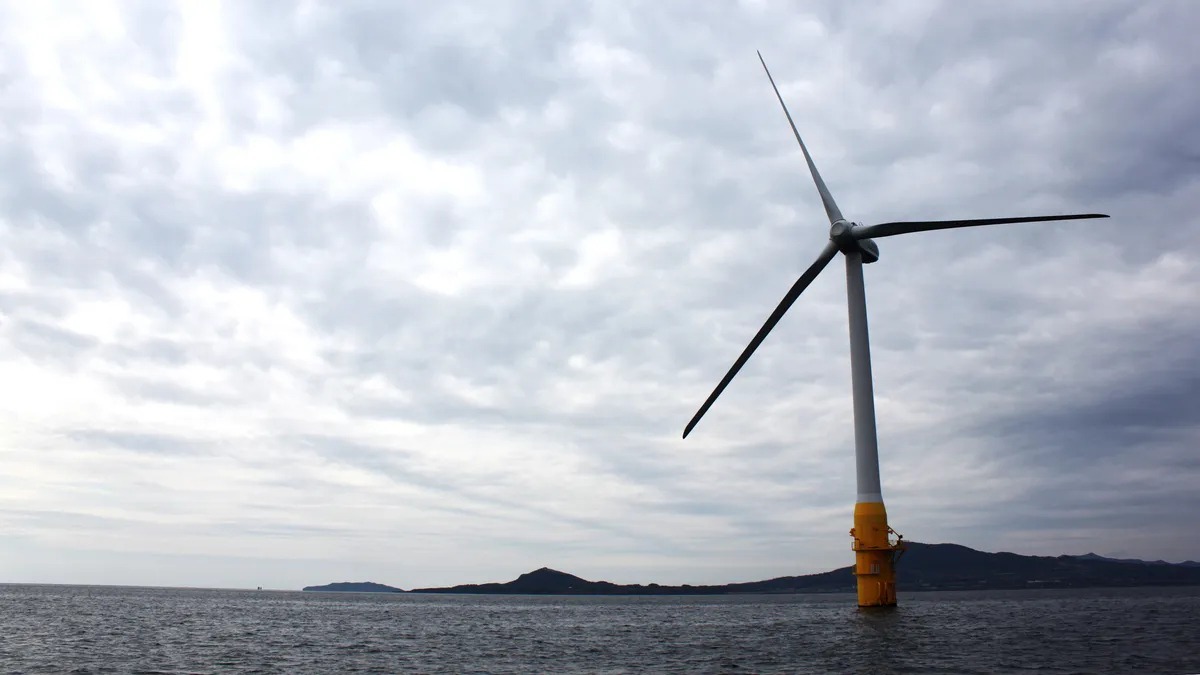Dive Brief:
- California officials and the Interior Department's Bureau of Ocean Energy Management (BOEM) are considering a roughly 320 square mile patch of the Pacific Ocean, just off the central California coast, as possible sites for offshore wind energy development.
- The areas were identified by a group of stakeholders including BOEM, the U.S. Department of Defense (DOD) and the National Oceanic and Atmospheric Administration. Now, regulators at the California Energy Commission (CEC) are looking for public feedback on whether the areas are appropriate for offshore wind development, as part of the state's broader goal to deliver 100% carbon-free electricity by 2045 — a goal that experts say will require diversifying resources.
- "Offshore wind could help provide this balance, as it appears to be a good complement to other plentiful renewable resources in the state — most notably solar," Eli Harland, advisor to CEC Commissioner Karen Douglas, said at a virtual workshop Wednesday.
Dive Insight:
The state's central coast presents particular opportunities for offshore wind development, since it is equipped with transmission infrastructure that was built to carry deliveries from the 2,000 MW Diablo Canyon nuclear plant — which is scheduled to be decommissioned starting in 2024 — and a second retired 1,000 MW power plant.
In late 2018, BOEM published calls for information and nominations for two areas off the California coast. Both, however, are used by the DOD, which determined that offshore wind development could conflict with its activities.
Last year, stakeholders formed the working group, which in May released a report identifying potential zones located in and around the Morro Bay call area that wouldn't interfere with the DOD's activities. There are around 215,000 square miles of federal waters off California's coast, Jean Thurston-Keller, task force coordinator at BOEM, said at the workshop — but after taking into account water depth, wind speeds, protected areas and other considerations, only 6% of that is available for possible offshore wind development.
The sites identified by the group include a North and South area, amounting to roughly 240 square miles, located around 15 miles off the coast, as well as a 90-square mile site located within the Monterey Bay National Marine Sanctuary. However, since BOEM doesn't have the authority to lease out areas in a sanctuary, the group has labeled that site for further discussion.
The DOD is committed to working with stakeholders "to explore the possibility of offshore wind that avoids adverse impacts to our military operations on testing and training requirements," Steve Chung, a DOD representative, said at the workshop.
One of the big advantages of offshore wind is that it complements the profile of solar energy, Nancy Rader, executive director of the California Wind Energy Association, told Utility Dive — as the sun goes down, the wind comes up — and adding offshore as well as out-of-state wind could reduce the need for storage, saving California around $19 billion per year by 2045, she said.
And advocates also point to the economic benefits of developing offshore wind, especially as the U.S. grapples with the economic fallout of the COVID-19 pandemic.
"There are 40 million Americans that are unemployed right now. This is a once-in-a-generation economic development and recovery opportunity," Brandon Burke, policy and outreach director for the Business Network for Offshore Wind, said at the workshop.
But the industry faces several challenges in California, Mohit Chhabra, senior scientist with the Natural Resources Defense Council's climate and clean energy program, told Utility Dive. Environmentally, policy-makers need to figure out how to develop facilities without causing harm to marine ecosystems. Navigating the permitting requirements and other obstacles that come from using waters that are used by the DOD can be complicated. And there are economic issues as well.
"When it comes to building specific projects there's a chicken-and-egg problem — without actually building, we wouldn't actually know the environmental issues or [be able to] work through all the regulatory issues. But when we do build, we need to build something that's worthwhile enough for investors," because projects have to be big enough to be cost effective, he said.
The prospect of a Central California offshore wind facility has also drawn ire from representatives of the fishing industry. But the industry on the East Coast has confronted similar issues, according to Nancy Kirshner-Rodriguez, Western director for the Business Network for Offshore Wind.
"I am optimistic that we can confront and come to a good result with the military, with the fishing industry," she told Utility Dive, adding, "You're able to see a broad coalition of interested parties coming together to try to figure out how we can put utility-scale renewable energy into the ocean in an environmentally sustainable way."















